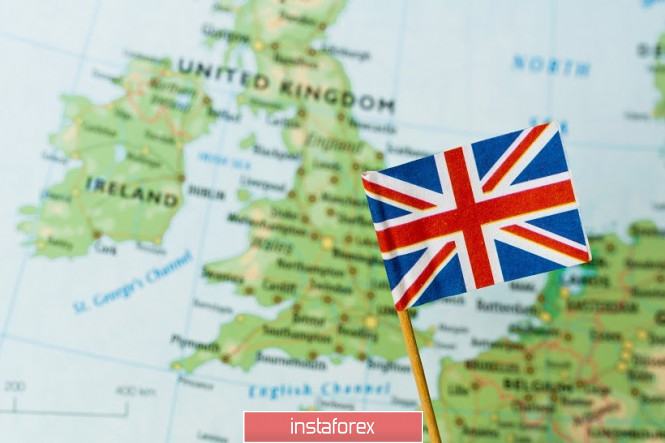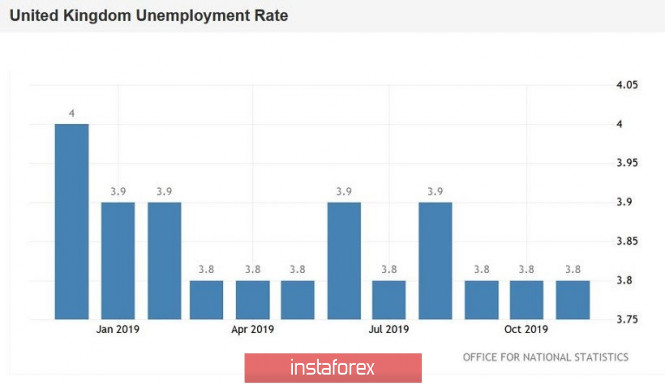Before traders of the GBP/USD pair had time to get used to the idea that the Bank of England would soon resort to a preventive rate cut, the British labor market was surprised by an unexpected increase. The British economy has recently regularly surprised investors, though, as a rule, in a negative context. The country's GDP is declining, inflation has been growing at the slowest pace since 2016, retail sales have completely collapsed into the negative region, despite the pre-holiday December period. With each report of this kind, the probability of a decrease in the interest rate naturally increased, all the more so as the dovish sentiment was fueled by the relevant comments of the representatives of the English regulator. Today's release on the growth of the British labor market could complement the general fundamental picture for the GBP/USD pair - the puzzle finally developed if the numbers came out in the red zone.

However, British labor market data supported the pound. Despite a significant increase in applications for unemployment benefits, the pair adjusted almost to the boundaries of the 31st figure. Traders drew attention to the positive aspects of the release: firstly, the unemployment rate remained at a record low value of 3.8%, and secondly, the level of salaries (including premiums) remained at 3.2% in annual terms, although experts predicted a decline to a three percent level. As for the number of applications for unemployment benefits, the situation here is as follows. According to forecasts of many economists, this figure was supposed to exceed multi-year highs in December. According to some estimates, it could jump to 40 thousand, while others said it could reach up to 55 thousand. But in reality, this indicator came out at the level of the previous month, that is, at around 14 thousand. In other words, the result itself is not positive, however, given previous expectations, it fully satisfied the bullish appetite. All this made it possible for the pair to demonstrate a small correctional growth.
By and large, GBP/USD buyers became active only for one reason - market participants doubted that members of the BoE would lower their interest rates at the January meeting, which will be held next Thursday. Three members (out of nine) of the Committee are guaranteed to vote for a cut in the rate - from among those who have publicly stated the need for easing monetary policy (Vlieghe, Saunders and the recently joined Tenreyro). But most of their colleagues can still give the British economy another chance to independently get out of this situation. At least this logic guides the buyers of the GBP/USD pair. Last week, the likelihood of monetary easing on January 30 was almost 80%. At the moment, the chances are down to 65%.
And yet, in my opinion, the position of the British currency looks precarious. Traders of the pair were too emotional about the release of data on the labor market, as it was the only one of many releases that supported the pound. Nevertheless, the rest of the statistical reports cannot be saved - the members of the English regulator will either have to "close their eyes" to them or react accordingly. And even if members of the Bank of England do not dare to lower their rates next Thursday, they can take an extremely soft position - right up to the announcement of easing monetary policy at one of the next meetings. Therefore, the euphoria of GBP/USD bulls is unlikely to be long.

Also, remember that the pound remains vulnerable due to the Brexit factor. Let me remind you that recently the pair plunged into the region of the 29th figure not only because of a series of disappointing statistics. The British finance minister, Sajid Javid, also had an influence on the Briton. He also said that after Brexit "there will be no trade agreements with the EU." According to the minister, large companies "had three years to prepare for a change in trade relations with the European Union." Such harsh statements worried market participants, after which the pound lost its foothold and fell into the 29th figure.
It is worth noting that during the transition period, officials and (especially) politicians (both British and European) will voice a variety of speculative statements, as the negotiations between Brussels and London promise to be difficult. And each such speech will exert strong pressure on the British currency, slowing the upward trend of GBP/USD or strengthening the downward one.
Thus, the pair's traders got a reason for corrective growth today, however, it is impossible to speak about long-term upward movement. After the first emotions from today's release come to naught, the price will return to the bottom of the 30th figure with a possible test of 29 price levels. The negative macroeconomic reports that were published earlier this year will continue to crush the pair - until January 30, when the BoE does not reach a verdict.
The material has been provided by InstaForex Company - www.instaforex.com